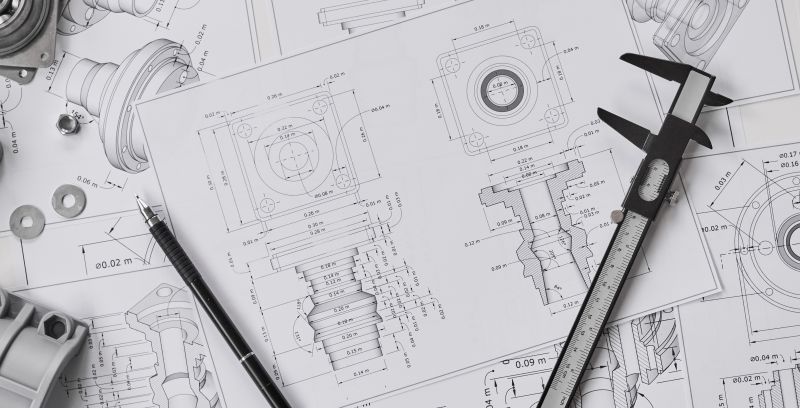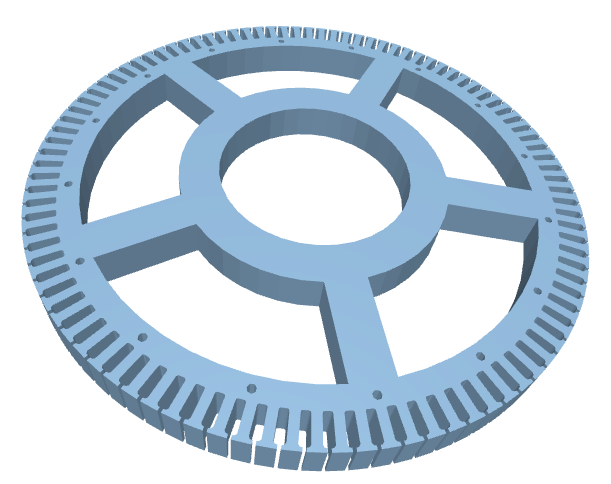Quoting Sheet Metal With a Print vs CAD Files

Ordering Custom Sheet Metal Parts with Prints
Several years ago, before co-founding OSH Cut, I was hunting for a vendor to laser-cut laminations for a custom motor (for the design below, in fact!) The design called for around 100 laminations at 24" in diameter each. The general response won't be surprising for anyone who has ordered in this industry before: of the ten vendors who received my quote request, only five responded. Prices were all across the board, ranging from several hundred to several thousand dollars.

So far, so expected. What really surprised me at the time was how reluctant sheet metal shops were to use a CAD model or DXF profile to bid on the job. They really wanted a print. On one hand, that makes sense, especially for something engineered like a custom motor lamination. A well-made print will contain all dimensions and tolerances required to make the part, and unrealistic tolerance requirements can be flagged well before production. On the other hand, the quoting process these vendors described to me was nothing short of horrendous. They took my print, paid an engineer re-draw the part using my drawing, created their own print for my approval, and then used their geometry to quote the job.
With so convoluted a workflow, it's no wonder that only half of them responded at all. This experience contributed to our desire to start OSH Cut, to fix sheet metal quoting and ordering workflow.
Manufacturing Prints vs CAD Geometry
Modern CAD tools allow engineers to design sheet metal parts with extraordinary speed and precision. CAD-native files like SolidWorks encode the geometry of a finished part with exactness. Taking that wealth of information and distilling it into a one or two-page print for another shop to re-create seems... ironic, at the very least, if not entirely baffling. Exchanging paper prints is a relic of processes that existed literally a century ago.
But prints have an important place, even when paired with CAD files - notably, they communicate design requirements and tolerances that you won't find in a CAD file. For sheet metal parts, that often includes requirements for edge rolling, surface treatments, bend angle tolerances, parallelism, and geometric tolerances. A hole designed for a PEM will ordinarily require a + 0.000" / -0.003" tolerance for proper fit, and cannot exhibit a lead-in artifact. A manufacturing print communicates all of this information without ambiguity.
On the other hand, manual review of a print is time-consuming and expensive. In our fast-moving world, waiting a week for an engineer to review a print to provide a price is a non-starter. So what's the solution?
An Example from the PCB Industry
Printed Circuit Boards (PCBs) can be extraordinarily complicated, but companies have figured out ways to avoid custom prints and redesign, in most cases. It starts with clear communication of capability and tolerances. For example, this vendor (OSH Park) communicates capabilities right up front - copper thickness, minimum hole sizes, minimum trace width and space between traces, minimum drill sizes, and so on.
Ordinarily, an electrical engineer will identify vendor capabilities and then use those capabilities to inform design. Then when it comes time to order, they can upload a set of "gerbers" (the common manufacturing file format for PCBs) and send them to vendors, who can use them to produce the design without issues.

It's possible to get crazy and do some amazing things with circuit boards. Specialized designs can call for upwards of 20 layers, laser-drilled, blind and buried, and copper-filled vias across any pair of layers, ultra-high copper thicknesses, extremely tight space and trace, controlled dielectrics, and 1000 other features that demand special capabilities and attention from vendors. These kinds of designs will often require manufacturing documents that go into extraordinary detail, much like a print in the sheet metal world.
And even for very simple designs, mass-production often demands careful attention to every detail. Messing up a single part prototype isn't a big deal, but missing the boat on a 1 million part production run would be a disaster.
So there is a distinction for PCBs. Designs that can be engineered for manufacturability don't require prints. It's enough to send a vendor well-designed gerbers and be done with it. For that reason, you can get custom circuit boards in a single day from many different companies. But if the design becomes very complicated, requires unusually tight tolerances, or is being mass produced, companies rightly start to require more documentation.
Sheet Metal Design for Manufacturability
The same should really be said for sheet metal. Designed correctly, sheet metal parts shouldn't require prints for quoting. If a part is designed with correct bend radii, resilience against cutting and bend angle tolerances, and for specific tooling, a print shouldn't be needed at all. Shops should be able to take the original 3D model of the sheet metal part and push it through production with minimal overhead, allowing for faster leads and dramatically reduced prices.
On the other hand, some parts are going to be more complicated. Some may require special tooling, custom-machined forms, or unusually tight tolerance requirements. In those cases, a longer lead and higher price from a traditional shop should be expected. Much like a printed circuit board, this is an argument for good design. If your sheet metal design uses standard processes and tolerances, you'll save a lot of time, and lot of money.
Sheet metal shops like OSH Cut should continuously work to expand capabilities, so that standard processes can accommodate a wider range of parts. Meanwhile, customers should design around tooling constraints communicated by their vendors. Over time, more complicated designs can become more common and be produced more quickly, for a lower price.
A Missing Distinction in Sheet Metal Fabrication
For most companies in the sheet metal space, there is very little distinction between standard and custom processes, or at least shops fail to communicate them. How many shops clearly communicate available tooling and design constraints? How many publish bend radii and k-factor constraints? How many shops identify minimum flange lengths for their tooling and standard materials? An engineer ought to be able to visit a vendor's website and get detailed information about capabilities without having to make a phone call, or wait for an email response.
Poor communication often characterizes the shop-customer relationship in this industry. Customers don't know how to prepare their designs for a shop's capabilities, and so create jobs that aren't manufacturable or that can only be produced with great difficulty. Shops in turn express frustration about customers who "don't know how to design for sheet metal." There is plenty of frustration, finger-pointing, and friction to go around. This lengthens quoting times, adds overheads, and motivates shops to turn a cold-shoulder on short-run or prototyping jobs that should be easy to do.
A Shift in Shop and Customer Expectations
Customers should expect shops to publish design constraints on their websites. If a shop doesn't, a customer should be thinking, "why in the world do I have to ask you this? Doesn't literally every customer you serve require this information?"
Meanwhile, shops should insist that customers acquaint themselves with design considerations readily available online.
At OSH Cut, we hope to see a shift in both shop and customer expectations in this industry. We've not only published our design rules for cutting and bending (in our material catalog), our system performs full DFM analysis after upload. That includes checking for features that could cause problems during cutting, but also full bending simulation, to ensure that bent parts can be produced.
Customers can design around known constraints, and upload 3D models as they go. Our system will automatically unfold sheet metal parts to create a flat pattern, tweak bend radii to match our tooling, and perform bend simulations and collision checks to ensure that we can make the part. If the part doesn't work, it is often clear how it needs to be modified to be produced with our tooling.
In the mean-time, when we can't produce parts, we can see why. Because customers are continuously uploading parts, we get a very clear picture of the most pressing needs, and we take steps to improve our standard capabilities to serve more customers. We understand that our bend tooling is (as of April 2022) fairly limited, but we are working on it!
We hope that other shops take notice and work to improve ordering processes as well. It'll be good for everyone if the sheet metal industry catches up and provides an improved experience across the board: more people will design for sheet metal if it's easier to design and order sheet metal parts, and both customers and shops will benefit.